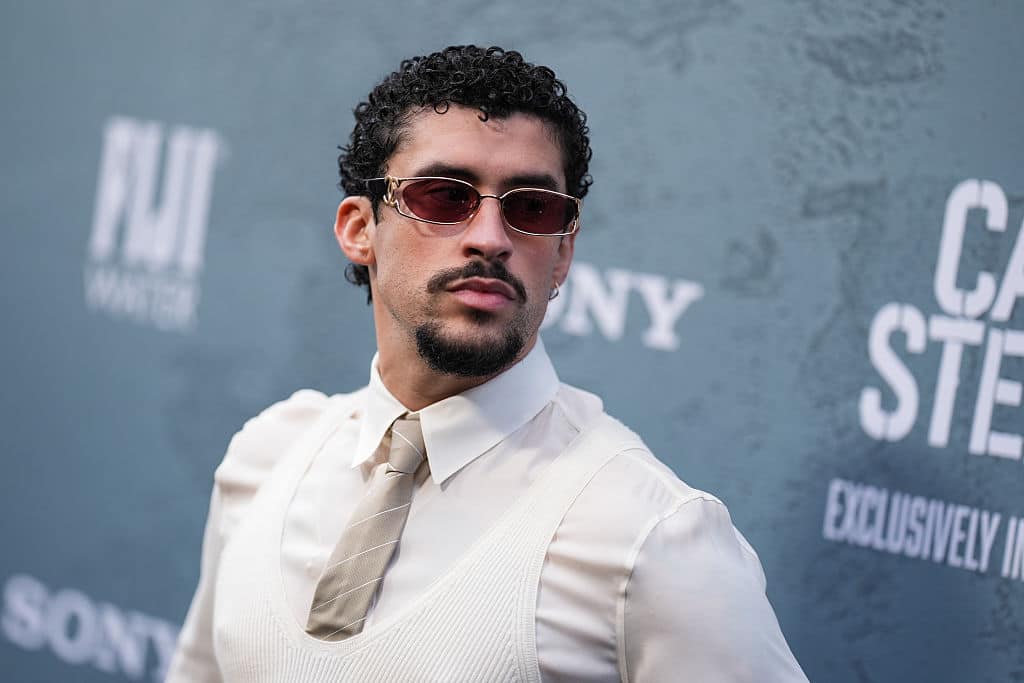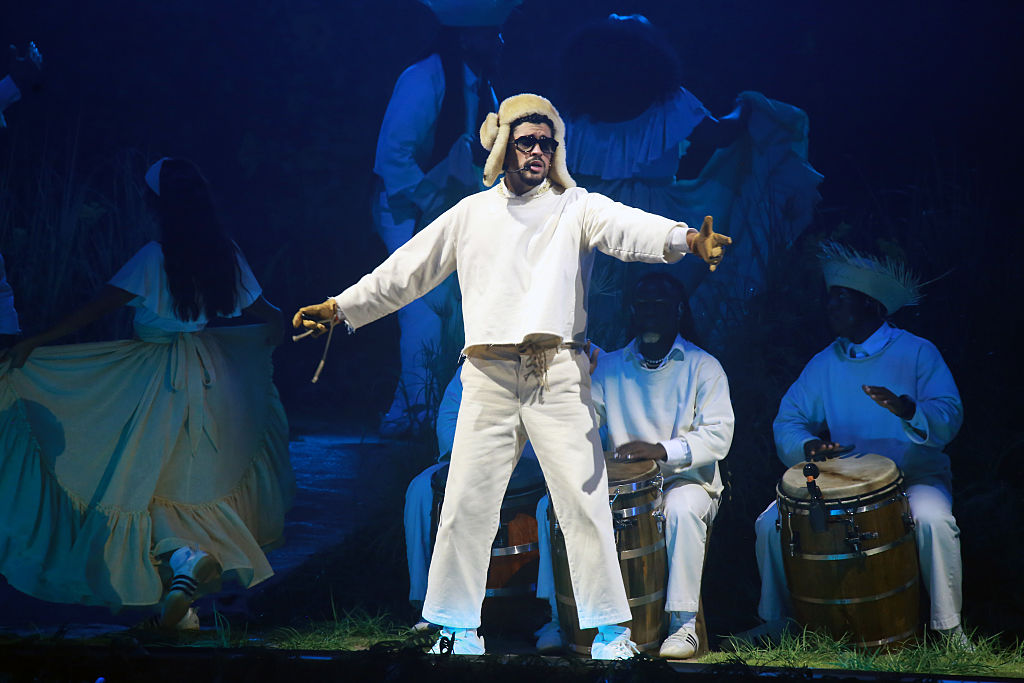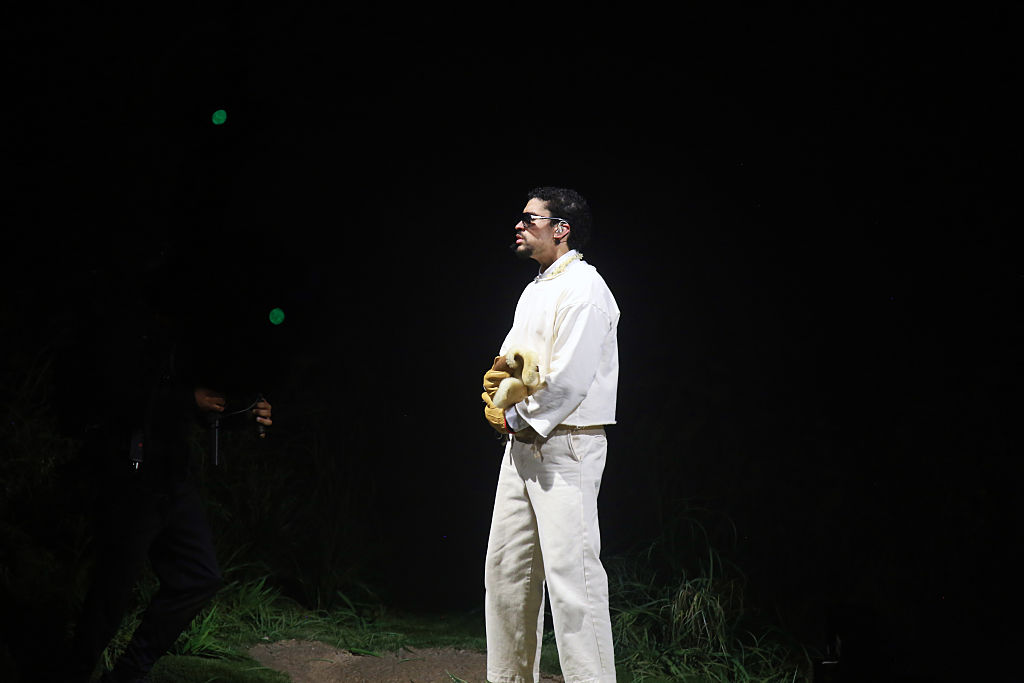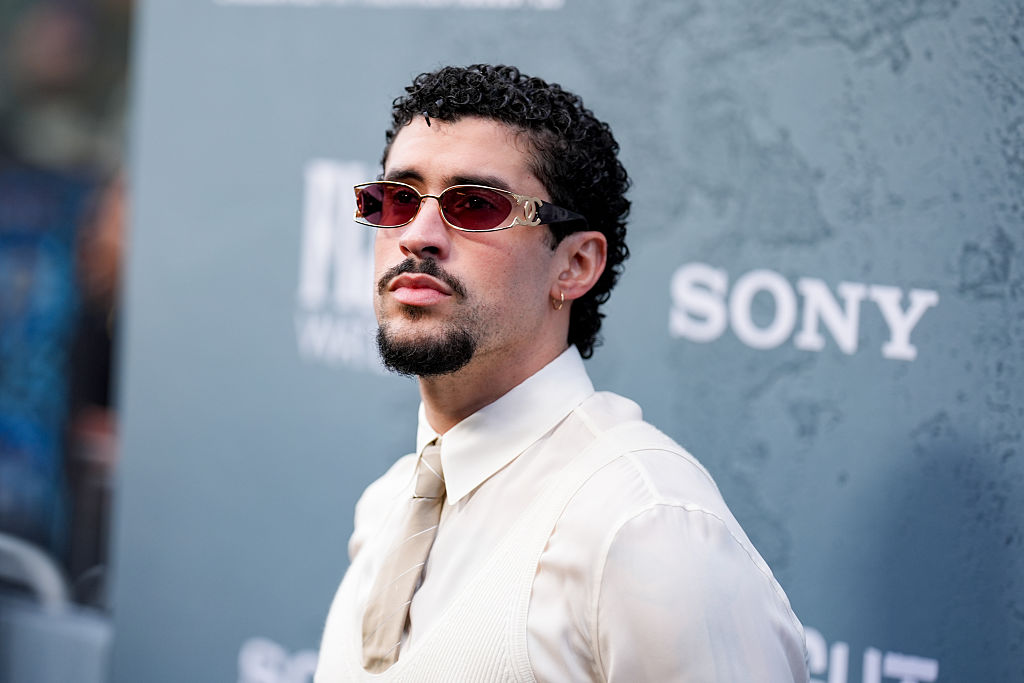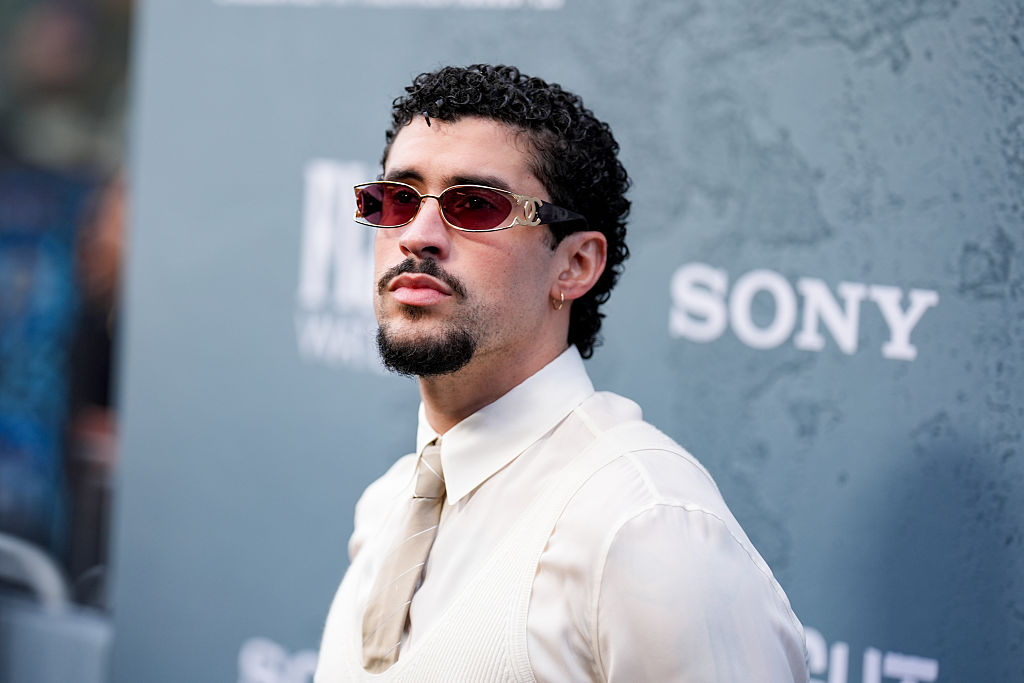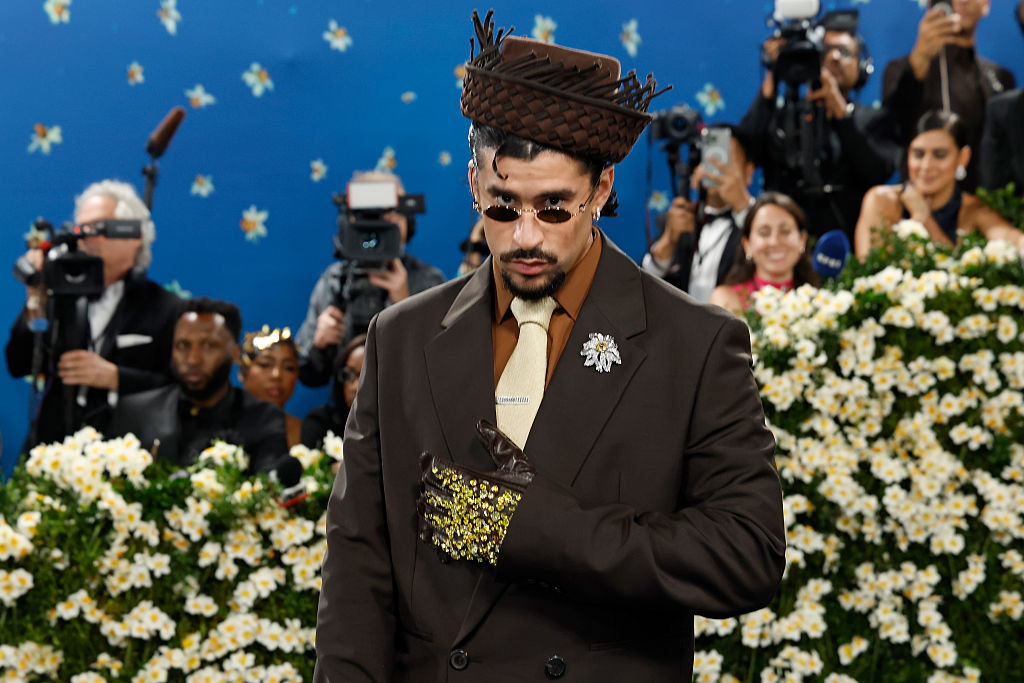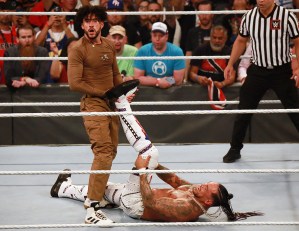Bad Bunny
Source: John Nacion / Getty
Bad Bunny’s influence has left a permanent imprint on popular culture. Now, Yale University has decided his impact is important enough to study indefinitely.
As per Newsweek, the prestigious Ivy League institution will continue offering its course dedicated to analyzing the Puerto Rican superstar’s career. Originally launched in April, “Bad Bunny: Musical Aesthetics and Politics” breaks down how the “MONACO” artist not only commands global fandom but also embeds political, cultural, and social commentary throughout his music. Topics explored include Puerto Rico’s threatened cultural identity post–Hurricane María and ways Bad Bunny has corrected mainstream misconceptions about the reggaeton genre.
The class’ popularity took Professor Albert Laguna by surprise — over 120 students attempted to enroll. Still, he intentionally kept the course small to maintain meaningful discussion. “I prefer small classes to develop the conversation, the connection between the students,” he told El Nuevo Día. Laguna also confirmed he plans to keep teaching the course as long as Bad Bunny remains relevant.
The timing is notable. Since being announced as the Super Bowl LX halftime performer, Bad Bunny has faced loud criticism from detractors who claim he’s unworthy of the spotlight. A petition opposing the NFL’s decision has already surpassed 100,000 signatures.
Bad Bunny attracted the ire of many once it was announced that the Puerto Rican superstar would be the featured performer at next year’s Super Bowl halftime set. Jay-Z, whose Roc Nation has helped put together the highly coveted performance slot, addressed the dustup around Bad Bunny in quick fashion.
TMZ reports that Jay-Z made a brief statement countering all the criticism regarding the decision to have Bad Bunny perform at Super Bowl LX. After the outlet asked Hov his thoughts on the artist born Benito Antonio Martínez Ocasio, the Brooklyn Hip-Hop and business icon initially didn’t want to have a conversation, but gave a quick soundbite.
“They love him, don’t let them fool you,” Jay-Z said regarding the singer and all the backlash Bad Bunny has received.
Jay-Z was clearly on the way to another destination, but graciously signed autographs while remaining tight-lipped about how Roc Nation and the NFL came to their decision.
The pushback against having Bad Bunny perform at Super Bowl LX has been high, with many decrying the fact that he’s a Spanish-speaking artist despite being an American citizen. Turning Point USA, the organization co-founded by the late Charlie Kirk, is reportedly putting together a countering halftime show featuring artists that they feel line up with what the country wants.
—
Photo: Getty
Source: Gladys Vega / Getty
Ever since it was announced that Puerto Rican superstar and Grammy award-winning artist, Bad Bunny, would be headlining the Super Bowl halftime show, MAGA country has been doing the most in their attempt to get him replaced before the big game. But their efforts have just suffered the ultimate setback, as NFL Commissioner Roger Goodell said, “Nah.”
According to Newsweek, Roger Goodell made it loud and clear that the global superstar would indeed be headlining the halftime show come Feb. 8, 2026, regardless of what some racist folk out there are demanding (he didn’t say that last part). While this led to anger and resentment from the MAGA cult on social media, they can at least take solace in knowing that they’ll have that extraordinary Turning Point USA counter show during the Super Bowl halftime show that’s rumored to feature the likes of Kid Rock and Lana Trump.
Should be a helluva show (LMAO).
Goodell doesn’t look like he’ll be losing any sleep over his decision, as he let everyone know where he stands on the issue.
Newsweek reports:
Love News? Get more! Join the Hip-Hop Wired Newsletter
We care about your data. See our privacy policy.
Defending the choice, Goodell said during a news conference: “The NFL is not considering dropping Bad Bunny. It’s carefully thought through. I’m not sure we’ve ever selected an artist where we didn’t have some blowback or criticism. It’s pretty hard to do when you have literally hundreds of millions of people that are watching.” He cited the importance of reflecting a global audience and commended Bad Bunny as “one of the leading and most popular entertainers in the world.”
Naturally, the decision didn’t go over too well with “conservative Christian” MAGA members, and they took to social media not only to slam Goodell and Bad Bunny, but even invoke a little religion while at it.
TPUSA Live host Jon Root said on X in a comment with over 2,200 views and 41 likes: “NFL Commissioner Roger Goodell said they won’t reconsider replacing Bad Bunny as the Super Bowl Halftime performer & went as far as saying his inclusion & performance will be a ‘unified moment’… Again, no one wants to watch a subtitled Super Bowl Halftime show, from a dude that dresses in drag, makes demonic music, & who stated he wouldn’t perform in the US anymore because of ICE deporting illegal immigrants. TPUSA’s All-American Halftime Show is gonna blow the Bad Bunny’s ratings out of the water.”
We swear those people think any music that comes from Black or Brown artists are “demonic” in nature. We get why they would say that about Lil Nas X, but artists like Rihanna, Beyoncé and now Bad Bunny? Come on, b.
What do y’all think about Roger Goodell standing on business when it comes to Bad Bunny headlining the Super Bowl halftime show? Let us know in the comments section below.
Bad Bunny, who, last we checked, is a citizen of the United States and has become the enemy of right-wing criticism from the MAGA faithful. Bad Bunny can now breathe a sigh of relief as the NFL has decided to keep the Puerto Rican superstar on the bill for the Super Bowl LX Half Time Show.
In a report from the Associated Press, NFL Commissioner Roger Goodell, no stranger to combating controversy around musical acts on one of the biggest stages in the world, offered a brief statement to those who decried the decision to have Bad Bunny perform at Super Bowl LX.
“It’s carefully thought through,” Goodell said during a news conference after the NFL’s annual Fall League meeting. “I’m not sure we’ve ever selected an artist where we didn’t have some blowback or criticism. It’s pretty hard to do when you have literally hundreds of millions of people that are watching.”
Goodell continued, “We’re confident it’s going to be a great show. He understands the platform that he’s on, and I think it’s going to be exciting and a united moment,” concluding the defense of the Spanish-speaking American singer with, “He’s one of the leading and most popular entertainers in the world. That’s what we try to achieve. It’s an important stage for us. It’s an important element to the entertainment value.”
President Donald Trump claimed that he didn’t know who the singer born Benito Antonio Martínez Ocasio was during a Newsmax interview. Further, Turning Point USA, the right-wing group founded by the late Charlie Kirk, said it would like to put on a halftime show of its own in defiance of the NFL’s move.
On social media, fans of Bad Bunny and the NFL alike are chiming in with thoughts regarding Goodell’s decision.
—
Photo: Getty
Bad Bunny, who, last we checked, is a citizen of the United States and has become the enemy of right-wing criticism from the MAGA faithful. Bad Bunny can now breathe a sigh of relief as the NFL has decided to keep the Puerto Rican superstar on the bill for the Super Bowl LX Half Time Show.
In a report from the Associated Press, NFL Commissioner Roger Goodell, no stranger to combating controversy around musical acts on one of the biggest stages in the world, offered a brief statement to those who decried the decision to have Bad Bunny perform at Super Bowl LX.
“It’s carefully thought through,” Goodell said during a news conference after the NFL’s annual Fall League meeting. “I’m not sure we’ve ever selected an artist where we didn’t have some blowback or criticism. It’s pretty hard to do when you have literally hundreds of millions of people that are watching.”
Goodell continued, “We’re confident it’s going to be a great show. He understands the platform that he’s on, and I think it’s going to be exciting and a united moment,” concluding the defense of the Spanish-speaking American singer with, “He’s one of the leading and most popular entertainers in the world. That’s what we try to achieve. It’s an important stage for us. It’s an important element to the entertainment value.”
President Donald Trump claimed that he didn’t know who the singer born Benito Antonio Martínez Ocasio was during a Newsmax interview. Further, Turning Point USA, the right-wing group founded by the late Charlie Kirk, said it would like to put on a halftime show of its own in defiance of the NFL’s move.
On social media, fans of Bad Bunny and the NFL alike are chiming in with thoughts regarding Goodell’s decision.
—
Photo: Getty
As of press time Bad Bunny is still scheduled to perform at the Super Bowl Halftime Show in February. While MAGA country continues to call for a replacement of the Puerto Rican superstar, it seems like they’re getting some support from the host of KIRO Newsradio, Gee Scott.
Gee Scott, who also was no fan of Kendrick Lamar’s superb Super Bowl Halftime Show earlier this year, went on The Gee and Ursula Show and actually said he’d like to see someone else take on halftime duties as he won’t “understand” what Bad Bunny is saying on stage the same way he didn’t understand what Kendrick Lamar did with his show.
Now that Bad Bunny is set to take on the big stage this coming February, Scott doesn’t like that choice much either and made no bones about it on his program.
Love News? Get more! Join the Hip-Hop Wired Newsletter
We care about your data. See our privacy policy.
During a recent radio segment, Scott revealed that he agreed with conservatives and MAGA country over their disdain for Bad Bunny.
“My daughter loves Bad Bunny, a lot of people do, but I am actually on the side of the Conservatives and whoever out there,” Gee said. “In 2020, it was Shakira and Jennifer Lopez, 2021 was The Weeknd, and in 2022 it was Dr. Dre, Snoop, and Eminem. People are thinking, ‘Can we get something for us next time?’ Then you gave them Kendrick Lamar last year, and they pushed the limits.
“I’m not saying George Strait, but Jay Z, who makes the decision, can you give us something? Give some love,” Gee continued. “You’re going to hit me with Kendrick Lamar last year, and I didn’t understand that. Then you hit me with Bad Bunny, I’m not going to understand that either.”
Well, given the current state of America, there’s always a chance that he and MAGA country may get their wish as we have a vindictive orange overlord sitting in the White House who just may issue an executive order banning Bad Bunny from doing the Super Bowl. It really is that crazy in this timeline y’all voted us into.
Then again, Gee Scott and others can always enjoy the Turning Point USA counter-halftime show to the Super Bowl that’ll allegedly headlined by “superstars” like Kid Rock and Lara Trump.
Decisions decisions.
What do y’all think about Gee Scott not feeling Bad Bunny for the Super Bowl after saying he didn’t like Kendrick Lamar either? Let us know in the comments section below.
—
Photo: Getty
Source: Taylor Hill / Getty
For the past few weeks, the American people have been speaking up against Donald Trump’s fascist regime amid his hardcore immigration crackdown, which has led to quite a few Americans and neutralized citizens getting caught up in his dragnet of apparent ethnic cleansing. But while we see his own personal Gestapo terrorize Black and Brown communities in LA, New York and other cities, many aren’t aware that ICE is also invading the often-overlooked island of Puerto Rico.
Yes, Puerto Rico too has been dealing with ICE raids as masked white men rummage through the Borinquen streets and search for illegal immigrants on the island. Many of its residents aren’t pleased with what they’re seeing including its most famous superstar today, Bad Bunny. Taking to social media to show ICE “agents” harassing everyday people while they work, Bad Bunny cursed out ICE (in Spanish of course), called them “sons of b*tches” and slammed them for terrorizing everyday working people in the streets of Puerto Rico.
While it may be a bit confusing as to why ICE is on a Latino island looking for Latinos to deport, the U.S. commonwealth does house quite a few people from places like the Dominican Republic, Haiti, and other countries that aren’t part of the U.S.
Still, Puerto Ricans are known to have welcomed people from all places to their island, but this current American regime is having none of that. With numbers suggesting that up to 20,000 illegal immigrants live in Puerto Rico and ICE having a quota to meet of 3,000 deportations per day, it doesn’t seem like ICE will be leaving the good people of Puerto Rico (or America for that matter) alone anytime soon.
On the bright side, there is word that ICE is already a billion dollars over budget and may soon run out of money to keep operations going. Still, it feels like in Trump’s America, hate will always find a way to flourish even at the expense of decent people.
What do y’all think about ICE carrying out deportation operations in Puerto Rico? Let us know in the comments section below.
HipHopWired Featured Video
HipHopWired Featured Video
Source: Monica Schipper / Getty
The Ivy League is recognizing Bad Bunny’s greatness. Yale University has announced they will be offering a course about the singer’s cultural impact.
As spotted on Hypebeast, the New Haven, Conn.-based school will be kicking off a course dedicated to Bad Bunny’s indelible influence on the world. Titled “Bad Bunny: Musical Aesthetics and Politics,” the class details how his music has not only shaped the Puerto Rican diaspora but helped put a spotlight on his island’s rich history. Albert Laguna, Associate Professor of American Studies and Ethnicity, Race & Migration, says that Bad Bunny’s latest project DeBÍ TiRAR MáS FOToS inspired the course. In an exclusive interview with The Yale Daily News he explained how the idea came to life. “I was walking around New Orleans, caught up in the Caribbeanness of the city, just listening to the album over and over again,” Laguna said. “I was taken by how every song opens up avenues of exploration in relation to topics that are important to me.”
The professor went on to further detail the the importance of the curriculum. “Of equal importance will be our engagement with how musical genres and aesthetic choices manifest these histories and challenges as well,” Laguna said. “You can ‘hear’ what the mass migration of Puerto Ricans made possible. Reggaeton in Puerto Rico cannot be divorced from musical flows in the region inseparable from colonial projects in the Americas, and locally, the politics of policing on the island. The class will be attuned to these histories and their sonic manifestations.”
Released Jan. 5, DeBÍ TiRAR MáS FOToS served as Bad Bunny’s personal love letter to his home town. The effort blended different elements of the island’s diverse music while his lyrics explored a wide array of the problems Puerto Rico faces including gentrification, political corruption and a fading cultural identity. DeBÍ TiRAR MáS FOToS has gone one to be recognized by fans and critics alike as his magnum opus. It has since gone on to sell over a million records in several countries.
When WWE Superstar Damian Priest learned that one of the biggest matches of his career would be held in Puerto Rico, he was overjoyed. For Priest, who was raised in Vega Baja, a small town just 26 miles from San Juan, it was more than a match — it was a long-awaited homecoming. But for this no-holds-barred San Juan Street Fight, the former World Heavyweight Champion would be lacing up his boots to face an unusual opponent: one of music’s brightest stars and arguably Puerto Rico’s favorite son, Bad Bunny.
“Here he is doing all these moves and being able to take them,” Priest recalls of the May 6, 2023, barn burner, where he lost by pinfall. “The fact that he could take all these hits and get back up — and I know he was in a lot of pain — that drive to succeed and entertain, he has it, like we all do.”
Bad Bunny actually made his WWE debut in January 2021, at the Royal Rumble in St. Petersburg, Fla., where he faced off against former WWE and UFC heavyweight champion Brock Lesnar. That April, he showcased more daredevil moves and aerial tactics — and turned skeptics into believers — at WrestleMania. And since then, he has continued to solidify his heavyweight status in the wrestling world with his unwavering passion for the craft.
Trending on Billboard
“Music and WWE have always run parallel,” Priest says. “When I describe how to make it in this business through the grind and the struggle, it’s always easier to explain it to musicians because they get it. It’s the same grind. You start performing in front of little to nobody in these greasy clubs, try to get noticed and then build up a reputation and a bit of a following. Hopefully, you get noticed by a record label or an artist who puts you on a tour, [and] it’s the same thing here.”
Bad Bunny and Damian Priest wrestle during the WWE Backlash at Coliseo de Puerto Rico José Miguel Agrelot on May 6, 2023 in San Juan, Puerto Rico.
Gladys Vega/ Getty Images
Though the WWE has been around for 70 years, the wrestling conglomerate is enjoying a renaissance — and the music industry has played a significant role in its post-pandemic resurgence. WWE president Nick Khan, who joined the company in 2020, has been at the forefront, connecting the dots between music and the WWE by bringing artists like Bad Bunny, Travis Scott, Metro Boomin, Cardi B, Meek Mill, Jelly Roll and Sexyy Red to collaborate with the company. Whether through actual matches, live TV segments or commercials for future premium live events, the strategic pairing has brought a fresh and diverse audience to WWE while elevating these artists’ status in the wrestling world.
In early January, WWE officially partnered with Netflix to present Monday Night Raw, its 34-year-old flagship show and the longest-running weekly episodic program without reruns in TV history. (The show most recently aired on USA Network from 2005 through the end of 2024.) The three-hour star-packed extravaganza featured wrestling immortals The Rock, John Cena and Hulk Hogan, and celebrities from Vanessa Hudgens and Tiffany Haddish to Travis Scott, Wale and Blxst attended. But unlike his peers, Scott wasn’t just a spectator — he escorted WWE Superstar Jey Uso ahead of his match. Scott — whom WWE chief content officer Paul Levesque (aka wrestler Triple H) gifted a Hardcore Championship belt during the rapper’s ComplexCon performance last November — wore the title draped around his shoulders and fed off the crowd’s electric energy as his own “Fein” reverberated throughout Los Angeles’ Intuit Dome. Sunglasses on and joint in hand, Scott sauntered out alongside Uso with the aura of a ’90s wrestler — a picture-perfect moment for both stars.
“The energy out there was crazy,” Scott tells Billboard. “I was talking to Triple H and was like, ‘Yo. This s–t is wild.’ In my shows, I try to create that maximum energy level and have the people feel they can reach the highest level of ecstasy as far as being happy and free. And in those environments — things like wrestling, and even in sports where the characters can be so free and create this livelihood for kids, adults and families — it’s dope.”
“When I found out I was coming out with Travis, I asked him, ‘Are you ready? Because this s–t is about to pop off,’ ” Uso adds. “I just didn’t expect that the brother was about to light one up before we walked out. He can do what he wants to do.”
This wasn’t the first time Uso had rubbed shoulders with a hip-hop superstar. Last April, at WrestleMania 40, he and Lil Wayne walked down the entranceway together at Philadelphia’s Lincoln Financial Field before a roaring crowd as the rapper’s “A Milli” and Uso’s entrance theme, “Main Event Ish,” played. It was a surreal moment for Uso: Before his WWE debut in 2007, he’d wrestled on the independent circuit alongside his twin brother, Jimmy, and they’d chosen Wayne’s 2004 hit “Go DJ” as their entrance music.
“We all grew up on Wayne in the late ’90s and early 2000s,” Uso says. “I’m talking about when he was with Hot Boyz and all that. It’s crazy how life comes full circle.” Before they walked out, Uso even cajoled Wayne into wearing some Uso merchandise: “He was real dope and cool with everything. He asked if I needed anything from him, and I said, ‘S–t, brother. Can you wear these “YEET” glasses for me? Here, put these on.’ ”
As artists rush to step inside the squared circle, wrestlers are moving with similar intention toward recording studios. Compelling entrance songs are vital in developing their characters, and since the ’90s, revered WWE Superstars like “Stone Cold” Steve Austin, The Rock and The Undertaker have placed fans in a choke hold with not only their iconic visual presentation but also their magnetic theme music. At the heart of those entrance songs is former WWE composer Jim Johnston, who used popular ’90s genres like hip-hop and rock to create songs based on the wrestlers’ characters.
For Austin, famously known as “The Texas Rattlesnake,” his hard-rocking entrance song, “I Won’t Do What You Tell Me,” became known for its glass-shattering sound effects. Austin didn’t record vocals for it, but Cena, whose earlier wrestling persona was a punchline-driven rapper, stepped inside the booth and rapped his “The Time Is Now.” That bold move paved the way for future superstars like Uso and Priest to infuse their entrances with their own personalities, adding a fun new element for fans to enjoy.
“It helps to have someone like [Slayer’s] Kerry King play guitar on my track,” says Priest, whose character has a darker, goth-like personality. “It’s pretty cool. While doing my own vocals on my song is pretty simple, it’s cool because it comes from me and what I wanted to say and feel during certain moments. People can bop their heads to it, and it adds to that aura.”
Bad Bunny, representing Latino World Order, takes the ring as he prepares to wrestle Dominik Mysterio during the WWE SmackDown at Coliseo de Puerto Rico José Miguel Agrelot on May 5, 2023 in San Juan, Puerto Rico.
Gladys Vega/ Getty Images
Uso’s hip-hop-influenced “Main Event Ish” is arguably the WWE’s most popular entrance song, with a simple but fiery hook (“It’s just me, Uce”), his unbridled energy and sharp ad-libs. His signature wave — now a staple at all WWE shows where he’s competing, in which he climbs the top rope and waves his hands up and down, controlling the crowd like a hip-hop maestro — accompanies the song.
“I flew to New York one day, sat [down with the writing team], put it together, knocked it out and it was on TV the next week,” Uso says of the track. “I knew I wanted to get on there and bring the energy. We always been musical, my whole family. We got hidden talents the world don’t know about.”
And as WWE enters WrestleMania season — with arguably its deepest roster since the ’90s — more musicians are looking to walk down the entrance ramp and pose a challenge, just like Bad Bunny first did four years ago. Fortunately for Bad Bunny, he had a great teacher in Priest, who, prior to their one-on-one showdown in Puerto Rico, served as his in-ring mentor and tag-team partner at WrestleMania 37, where they were victorious.
“A good match with another good wrestler is expected,” Priest says. “What I did with Bad Bunny was magic because nobody expected it. That’s not something you get to do all the time. I don’t know if I’ll ever get that chance again.”
This story appears in the Feb. 8, 2025, issue of Billboard.
With under two weeks to go until Saturday Night Live host their homecoming concert as part of their 50th-anniversary celebrations, the prolific Dave Grohl has been added to the lineup of performers.
Explore
Explore
See latest videos, charts and news
See latest videos, charts and news
Hosted by Jimmy Fallon, the SNL 50: The Homecoming Concert will take place at 8 p.m. ET on Feb. 14 at Radio City Music Hall in New York City, with live streaming available on Peacock. It’s part of the iconic show’s ongoing birthday celebrations which have also included the premiere of the 50 Years of SNL Music documentary on Jan. 27, and the SNL50: Beyond Saturday Night documentary on Jan. 16.
On Thursday (Jan. 30), SNL announced the names which will feature in their upcoming concert, with previous show hosts and performers Bad Bunny, Lady Gaga and Miley Cyrus appearing atop the bill.
Trending on Billboard
Elsewhere, the likes Post Malone, Jelly Roll and the Backstreet Boys can also be found on the bill, in addition to Arcade Fire, Bonnie Raitt, Brandi Carlile, Chris Martin, David Byrne, DEVO, Eddie Vedder, Jack White, Mumford & Sons, The B-52s and The Roots.
At the time, it was noted that more performers would be announced leading up to the show, with Consequence now confirming that Dave Grohl will also be joining the lineup.
Though absent from the initial announcement, a promotional video for the event has since mentioned Grohl’s presence. Notably, Grohl is the only artist featured in the video who was not named in last week’s lineup, though the clip also overlooks mention of confirmed performers Brittany Howard, Preservation Hall Jazz Band, and Robyn.
The Foo Fighters founder has been largely absent from the public eye since September 2024 when he announced he had become the father of a new baby born outside of his marriage to Jordyn Blum. “I love my wife and my children, and I am doing everything I can to regain their trust and earn their forgiveness,” a statement released by Grohl at the time read.
Grohl’s upcoming contribution to the SNL’s Homecoming Concert makes sense, however. To date, he holds the record for most musical appearances on the show, with 15 performances taking place between 1992 and 2023.
These include nine times with the Foo Fighters, twice with Nirvana, once as a drummer for Tom Petty and the Heartbreakers, and once as a member of Them Crooked Vultures. The Foo Fighters have also appeared as a special guest with Mick Jagger in 2012, and Grohl also performed with his Nirvana bandmates alongside Paul McCartney later that same year.
More recently, Grohl also appeared in the 50 Years of SNL Music documentary, and on Thursday (Jan. 30), took part in a Nirvana reunion as part of the FireAid LA Benefit Concert. Appearing alongside bandmates Krist Novoselic and Pat Smear, the four-song set featured guest vocalists St. Vincent, Kim Gordon, and Joan Jett, with Grohl’s own daughter Violet closing out proceedings with a rendition of “All Apologies”.

 State Champ Radio
State Champ Radio 